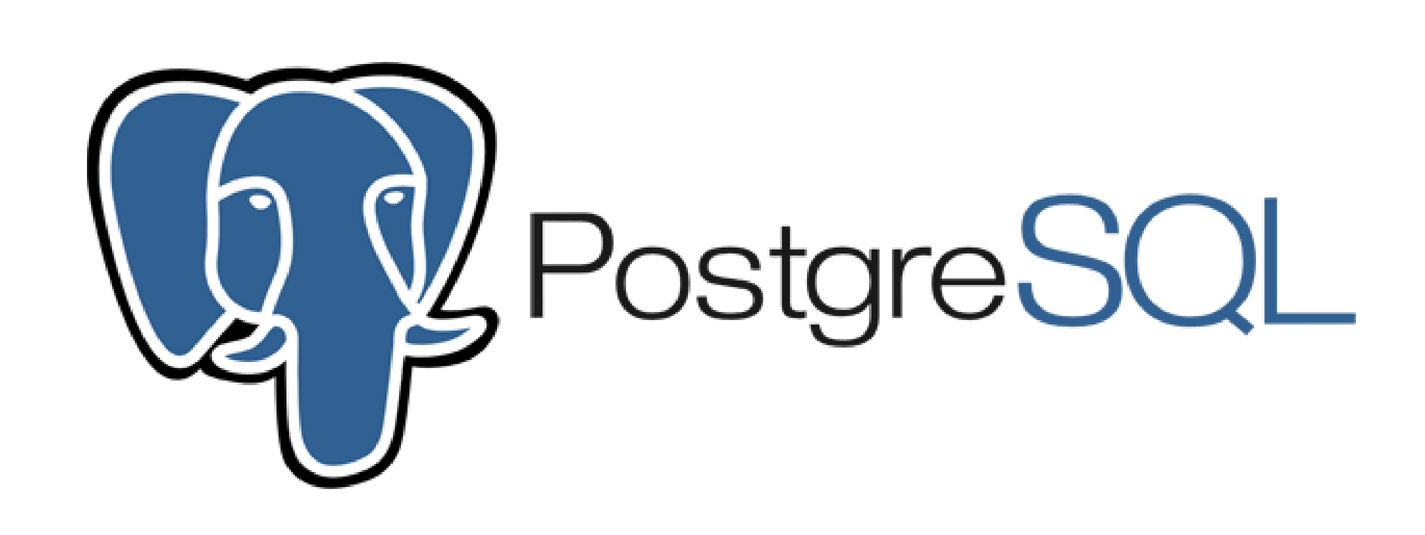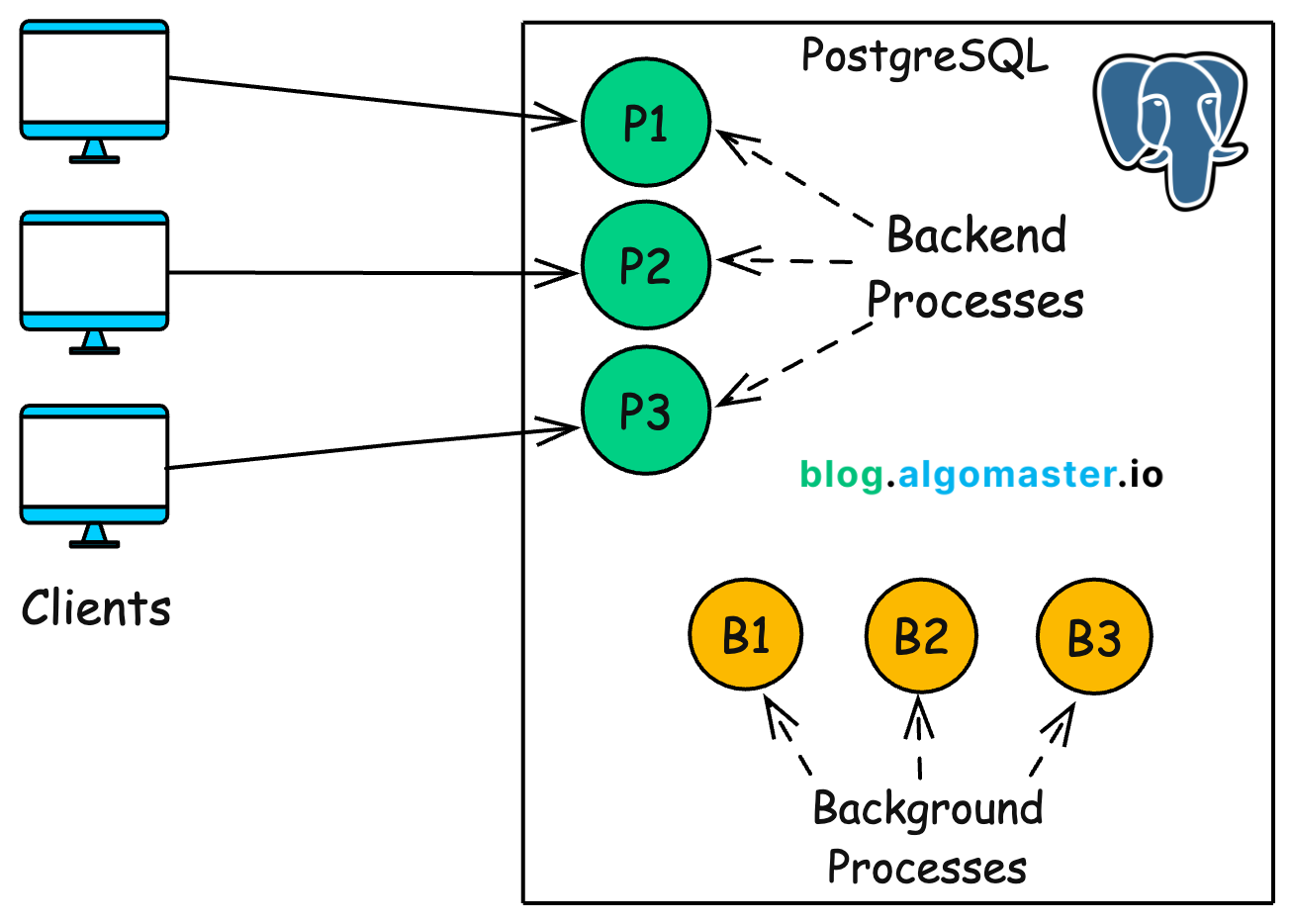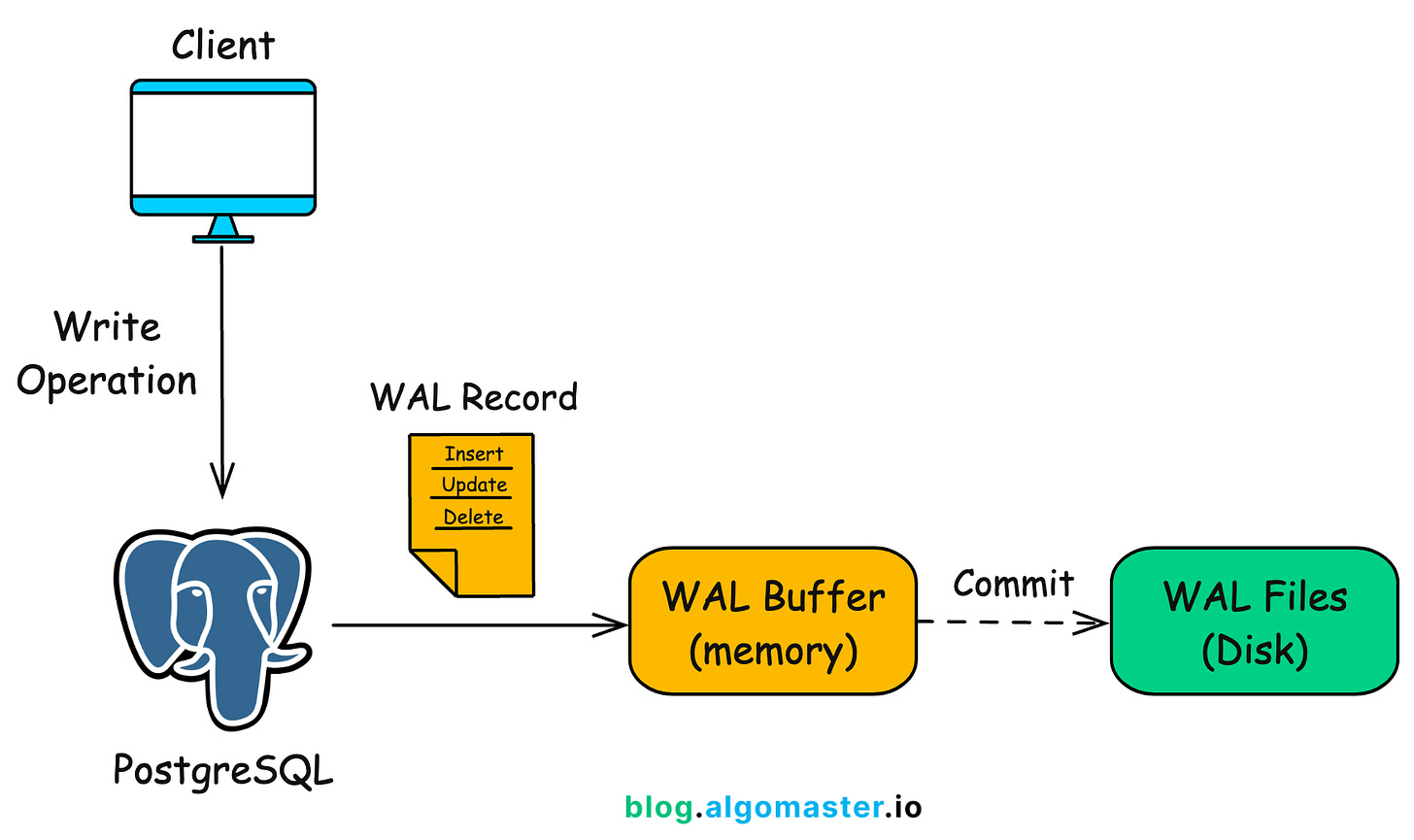How PostgreSQL Works: Internal Architecture Explained
This post is written in collaboration with Alexandre Zajac — Engineer at Amazon, tech creator, and author of the Hungry Minds newsletter.
In this post, we’ll explore how PostgreSQL works under the hood and dive into the architecture that makes it a powerful choice for a wide range of use cases.
PostgreSQL has emerged as one of the most powerful and versatile open-source relational databases, trusted by software engineers to handle everything from small applications to large-scale enterprise systems.
Its robustness, flexibility, and rich feature set make it a go-to choice for developers worldwide. But to truly harness its potential, understanding its internal architecture and advanced features is essential.
In this blog post, we’ll take a deep dive into PostgreSQL’s core components and capabilities, with insights that will help you optimize performance, scalability, and reliability in your applications.
We’ll explore:
-
Process-Based Architecture: How PostgreSQL manages connections for stability and isolation.
-
Write Ahead Logging (WAL): Ensuring data durability, crash recovery, and replication.
-
Multi Version Concurrency Control (MVCC): Allowing concurrent reads and writes without blocking.
-
Query Execution Pipeline: From parsing and planning to execution and result delivery.
-
Indexing System: Choosing the right index for your data.
-
Table Partitioning: Managing large tables efficiently with range, list, or hash-based partitioning.
-
Logical Decoding: Streaming changes for replication and change data capture.
-
Extensions: Extending PostgreSQL’s capabilities with custom features.
-
Statistics Collector: Real-time insights for monitoring and optimizing database performance.
Let’s get started!
1. Process-Based Architecture
PostgreSQL follows a process-per-connection architecture, meaning each client connection is handled by a dedicated operating system process.
When the PostgreSQL server (postmaster) starts, it listens for incoming connections on the configured port. For each new client connection, it forks a new backend process to handle that session. This backend process handles all communication and query execution for that client.
Once the session ends (i.e., the client disconnects), the associated process terminates.
This architecture differs from thread-based models used in some other databases (e.g., MySQL or SQL Server), where a single process spawns threads for multiple connections.
Why PostgreSQL Chooses Processes?
-
Isolation: Each connection runs in its own process, ensuring that if one session crashes, it doesn’t affect others. This design reduces the risk of memory corruption, race conditions, or resource conflicts between clients.
-
Stability: The process model provides a higher level of stability, as issues in one connection are contained within its process.
-
Simpler Internals: Since each connection is isolated, PostgreSQL doesn’t need fine-grained locking on every internal data structure (as thread-based systems do). This makes the system easier to maintain, debug, and extend.
Trade-Offs
While robust, this architecture does come with certain trade-offs:
-
Memory Overhead: Each backend process maintains its own stack and local memory for query execution. This can consume significant RAM, especially when many idle or parallel connections are open.
-
Connection Scalability: Handling thousands of concurrent client connections means creating thousands of OS processes. This can lead to high context-switching costs and pressure on kernel-level resources.
Best Practices
To maximize performance while retaining the benefits of PostgreSQL’s architecture:
-
Use a connection pooling like PgBouncer
-
PgBouncer sits between clients and PostgreSQL, reusing a small pool of persistent connections.
-
This drastically reduces process overhead while supporting thousands of clients.
-
-
Tune max_connections parameter in
postgresql.conf-
Don’t allow too many concurrent processes unless your hardware can handle them.
-
A common pattern: set
max_connectionsto ~200–500, and let PgBouncer manage the rest.
-
Background Processes
In addition to client backends, PostgreSQL runs persistent background processes, also forked by the postmaster at startup. Each has a distinct job and helps with system maintenance and performance:
-
Checkpointer: Periodically flushes dirty pages from shared buffers to disk (to bound recovery time)
-
WAL Writer: Writes WAL (Write-Ahead Log) changes from memory to disk
-
Autovacuum Workers: Automatically cleans up dead tuples and refreshes statistics
-
Background Writer: Continuously writes dirty buffers in the background to smooth out I/O spikes
-
Replication Workers: Handles streaming WAL to replicas for physical/logical replication
2. Write Ahead Logging (WAL)
Write-Ahead Logging (WAL) is one of PostgreSQL’s most critical mechanisms for ensuring data durability, consistency, crash recovery, and replication.
What Is WAL?
WAL is a sequential log of all database changes, written before those changes are applied to the actual data files (the heap or index pages). This ensures that, in the event of a crash or power failure, PostgreSQL can replay the log and restore the database to a safe and consistent state.
How WAL Works?
-
Client executes a write operation (INSERT, UPDATE, DELETE, DDL).
-
PostgreSQL generates a WAL record describing the change.
-
The WAL record is written to memory (WAL buffer).
-
On commit, the WAL is flushed to disk (fsync)—this makes the transaction durable.
-
The actual data files (heap pages) may be updated later, asynchronously by background processes (like the checkpointer or background writer).
-
In case of a crash, PostgreSQL replays the WAL from the last checkpoint to recover the lost changes.
Key Benefits of WAL
-
Crash Recovery: WAL replay brings the database to a consistent state after a crash. This ensures that no committed data is lost, even after a system failure.
-
Replication: Enables both synchronous and asynchronous replication for disaster recovery and read scaling. A replica essentially replays WAL just like crash recovery, but continuously, to stay in sync with the primary.
-
Point-in-Time Recovery (PITR): By archiving WAL, you can restore a backup and replay WAL to a specific point in time, essentially “time-traveling” the database to a desired state.
Managing WAL: Best Practices
If unmanaged, WAL can consume significant disk space. Here are ways to handle it:
-
Enable WAL archiving
archive_mode = on archive_command = 'cp %p /mnt/wal_archive/%f' -
Use
pg_archivecleanupor retention policies to delete old WAL files. -
Set appropriate checkpoint intervals (e.g.,
checkpoint_timeout,max_wal_size) to balance recovery time vs. runtime I/O. -
Use replication slots to avoid prematurely removing WAL needed by standby or logical consumers.
3. Multi Version Concurrency Control (MVCC)
PostgreSQL uses MVCC to handle simultaneous transactions without requiring heavy locking. MVCC is a powerful mechanism that allows reads and writes to occur concurrently by maintaining multiple versions of a row.
This ensures that every transaction sees a consistent snapshot of the database as it existed at the time the transaction began—regardless of ongoing changes by other users.
Why MVCC?
Traditional databases often use locks to prevent conflicts between readers and writers. However, this leads to blocking and contention:
-
Writers lock rows to prevent readers from seeing half-written data
-
Readers may block writers while reading data
PostgreSQL avoids this by using MVCC to isolate transactions without locking—resulting in high concurrency, better performance, and smoother scalability.
How MVCC Works?
When a transaction starts, PostgreSQL assigns it a unique transaction ID (XID).
PostgreSQL tracks versions of rows using hidden system columns:
-
xmin: The transaction ID that inserted the row -
xmax: The transaction ID that deleted (or updated) the row
Let’s say we have a table called accounts:
id | balance
---+---------
1 | 1000The current row has:
-
xmin = 100→ inserted by transaction ID 100 -
xmax = NULL→ it hasn’t been deleted/updated yet
What Happens During Reads?
When a transaction reads a row, it sees the version that was current at the start of the transaction:
-
It checks
xminandxmaxto determine if the row was visible at the time the transaction started. -
If another transaction later updates the row, it creates a new version with a new
xmin, leaving the original intact for other readers.
Transaction 1 (T1)
BEGIN; -- Transaction ID = 200
SELECT * FROM accounts WHERE id = 1;-
T1 sees the row with
balance = 1000 -
Since
xmin = 100andxmax = NULL, the row is visible to T1 -
T1 keeps using this snapshot of the database until it commits, even if the data is updated later
What Happens During Writes?
Writers create new versions of rows without blocking readers, ensuring high concurrency.
PostgreSQL never overwrites rows. Instead:
-
INSERT: Adds a new row with the current transaction’s XID in
xmin -
UPDATE: Marks the old row’s
xmaxand inserts a new row with a freshxmin -
DELETE: Only sets
xmax; the row remains until cleanup
This design ensures snapshot isolation—older transactions can still see the old versions of rows, even after they’re updated. Readers never block writers, and writers don’t block readers. Each sees the world as it existed at their transaction start.
Transaction 2 (T2) – A concurrent update
BEGIN; -- Transaction ID = 201
UPDATE accounts SET balance = 1500 WHERE id = 1;Here’s what happens internally:
-
The old row is updated:
-
Its
xmax = 201→ marking it as deleted by T2
-
-
A new row is inserted:
-
With
balance = 1500 -
Its
xmin = 201andxmax = NULL
-
So now there are two versions of the row:
Old version: balance = 1000, xmin = 100, xmax = 201
New version: balance = 1500, xmin = 201, xmax = NULLWhat Each Transaction Sees
-
T1 is still active and keeps using its snapshot from the beginning:
-
It sees the old row:
balance = 1000 -
It ignores the new row, because its
xmin = 201(which is after T1 started)
-
-
T2, meanwhile, sees:
-
The new row it just inserted:
balance = 1500
-
Once both transactions are done, PostgreSQL will still keep both row versions until the old one is no longer needed.
Cleanup: The Role of VACUUM
PostgreSQL stores all row versions in the table (heap) until it’s safe to remove them. But old versions don’t disappear automatically.
That’s where VACUUM process comes in:
-
Removes old row versions that are no longer visible to any transaction
-
Updates the Visibility Map so index-only scans can skip dead pages
-
Prevents XID wraparound by freezing old transaction IDs
PostgreSQL runs autovacuum in the background by default, but tuning its frequency is critical in high-write systems.
4. Query Execution Pipeline
When you run a query in PostgreSQL—whether it’s a simple SELECT * FROM users or a complex join across multiple tables, it goes through a well-defined five-stage pipeline.
Each stage transforms the query from raw SQL into actual database operations that return results or modify data.
The Five Stages of Query Execution
-
Parsing
-
PostgreSQL takes the raw SQL string and checks it for syntax errors.
-
It then converts the query into a parse tree — a structured, internal representation of what the query is trying to do.
-
-
Rewrite System
-
Think of this step as preprocessing or query transformation—reshaping the original request before planning.
-
PostgreSQL applies rules and view expansions to the parse tree.
-
For example, if the query targets a view, the system rewrites the view reference into its underlying query.
-
-
Planner/Optimizer
-
The planner generates multiple candidate execution plans for the query.
-
It estimates the cost of each plan using table statistics and selects the cheapest one.
-
Cost is measured in terms of CPU, I/O, and memory usage—not time directly, but an abstract “execution cost” unit.
-
-
Execution
-
PostgreSQL executes the chosen plan step by step.
-
Execution is Volcano-style, meaning each node requests rows from its child, processes them, and passes results upward.
-
-
Result Delivery
-
Once the executor produces result tuples, they are returned to the client (for SELECT), or used to apply changes (for INSERT/UPDATE).
-
Key Features in PostgreSQL’s Execution Engine
-
Parallel Query Execution: For large datasets, queries can be split across multiple CPU cores.
-
JIT Compilation: Complex queries can be compiled at runtime for faster execution.
Use the EXPLAIN command to analyze query plans and identify performance bottlenecks. For example:
EXPLAIN ANALYZE
SELECT * FROM orders WHERE customer_id = 123 AND order_date > now() - interval '30 days';5. Indexing System
Indexes are essential to database performance. PostgreSQL offers a variety of index types to optimize query performance for different data types:
-
B-tree (Default Index Type)
-
Best for: Equality and range queries (
=,<,<=,>,>=) -
Data types: Numbers, strings, dates—anything with a natural sort order
CREATE INDEX idx_price ON products(price);
-
-
Hash Index
-
Best for: Simple equality comparisons (
=only) -
Slightly faster than B-tree for some equality lookups, but limited in capabilities.
CREATE INDEX idx_hash_email ON users USING HASH(email);
-
-
GIN (Generalized Inverted Index)
-
Best for: Documents or composite values (arrays, JSON, full-text search) when you need to check if a document contains a value or perform membership checks.
-
Use case: Indexes every element inside a value (like words in a text field or keys in a JSON)
-- For full-text search CREATE INDEX idx_gin_content ON articles USING GIN(to_tsvector('english', content)); -- For JSONB CREATE INDEX idx_jsonb_data ON items USING GIN(data jsonb_path_ops); -- For array values CREATE INDEX idx_tags_gin ON posts USING GIN(tags);
-
-
GiST (Generalized Search Tree)
-
Best for: Complex, non-scalar data types (geospatial, ranges, fuzzy text search)
-
Use case: Stores bounding boxes or intervals and supports overlaps, proximity, containment. Underpins the PostGIS extension, range queries, and more.
-- For geospatial data (via PostGIS) CREATE INDEX idx_location_gist ON places USING GiST(geom); -- For range types CREATE INDEX idx_price_range ON items USING GiST(price_range);
-
-
SP-GiST (Space-Partitioned GiST)
-
Best for: Data with natural space partitioning (e.g., tries, quadtrees)
-
Use case: Prefix searches, IP subnet matching, k-d trees
-- For text prefix matching CREATE INDEX idx_prefix ON entries USING SPGIST(title);
-
-
BRIN (Block Range Index)
-
Best for: Huge, append-only tables where data is naturally sorted (e.g., time-series)
CREATE INDEX idx_log_time_brin ON logs USING BRIN(log_timestamp);
-
6. Table Partitioning
Table partitioning allows large tables to be divided into smaller, more manageable pieces based on range, list, or hash criteria. This improves query performance by enabling partition pruning, where only relevant partitions are scanned.
PostgreSQL supports declarative partitioning, which means you define partitions using standard SQL with the PARTITION BY clause.
Example SQL
To create a partitioned table by date range:
-- Create the partitioned parent table
CREATE TABLE measurements (
city_id INT NOT NULL,
logdate DATE NOT NULL,
peaktemp INT,
unitsales INT
) PARTITION BY RANGE (logdate);
-- Create child partitions for each year
CREATE TABLE measurements_2024 PARTITION OF measurements
FOR VALUES FROM ('2024-01-01') TO ('2024-12-31');
CREATE TABLE measurements_2025 PARTITION OF measurements
FOR VALUES FROM ('2025-01-01') TO ('2025-12-31');When you insert into measurements, PostgreSQL automatically routes the row to the correct partition based on the logdate value.
Partitioning Strategies
-
Range: Splits data by ranges of values (e.g., dates, numbers).
-
List: Divides data by discrete values (e.g., region codes {“APAC”, “EMEA”, …}).
-
Hash: Distributes rows evenly using a hash function (when range/list isn’t practical or balanced).
Partitioning reduces query times by avoiding full table scans. Ideal for time-series data or datasets that can be logically grouped (e.g., by region or category).
7. Logical Decoding
Logical decoding is the process of transforming PostgreSQL’s low-level WAL records into high-level change events like:
INSERT INTO customers (id, name) VALUES (1, 'Alice');
UPDATE orders SET status = 'shipped' WHERE id = 42;
DELETE FROM payments WHERE id = 7;It allows changes from the WAL to be streamed in a logical format, making it useful for replication and Change Data Capture (CDC).
How Logical Decoding Works?
-
PostgreSQL WAL contains all changes, but in a binary, low-level format
-
Logical decoding interprets WAL into high-level row changes
-
The output is emitted using an output plugin, such as:
-
pgoutput(used for PostgreSQL logical replication) -
wal2json(outputs changes as JSON) -
decoderbufs(outputs Protocol Buffers) -
test_decoding(for debugging/logging)
-
-
A replication slot is created to:
-
Track how much of the WAL has been consumed
-
Prevent PostgreSQL from deleting WAL segments that are still needed by a consumer
-
Use Case
-
Change Data Capture (CDC): Stream inserts/updates/deletes to message brokers (e.g., Kafka, RabbitMQ)
-
Real-time analytics: Sync changes into a data warehouse (like BigQuery or Snowflake)
-
Event-driven systems: Trigger downstream services on data changes
-
Cross-database syncing: Sync tables across PostgreSQL instances (or even to MongoDB/MySQL with external tools)
Note: Logical decoding requires extensions like wal2json for specific output formats, as it’s not built-in by default.
8. Extensions
One of PostgreSQL’s greatest strengths is its extensibility.
From its inception, PostgreSQL was designed to be modular and pluggable, enabling users to extend its functionality without modifying core source code.
This has turned PostgreSQL from a traditional relational database into a true data platform—capable of powering everything from analytics to full-text search, machine learning, and distributed systems.
What Are Extensions?
An extension in PostgreSQL is a package of additional functionality that can include:
-
SQL objects (functions, types, tables, operators)
-
Procedural language support
-
Native C code for performance
-
Background workers or hooks into the core engine
Once installed, extensions behave like built-in features, seamlessly integrated into the database engine.
Installing an Extension
Extensions can be created by the community or bundled with PostgreSQL. To install one:
CREATE EXTENSION pgcrypto;Extensions live in the share/extension/ directory and are managed through CREATE EXTENSION, ALTER EXTENSION, and DROP EXTENSION.
Popular Extensions
-
pgcrypto: Adds cryptographic functions for hashing, encryption, and password handling
-
pgvector: Enables vector similarity search, useful for machine learning and AI applications
-
PostGIS: Turns PostgreSQL into a geospatial database, supporting geometry, GIS queries, spatial indexing
-
Citus: Enables distributed PostgreSQL, allowing you to shard and scale out across multiple nodes
This flexibility makes PostgreSQL adaptable to a wide range of applications, from traditional relational databases to specialized data processing systems.
9. Statistics Collector
PostgreSQL’s statistics collector gathers real-time data on database activity, helping you monitor and optimize performance.
There are two main types of statistics PostgreSQL collects:
-
Cumulative Activity Statistics: Used for monitoring, autovacuum, and operational insights
-
Planner Statistics: Used by the query planner to optimize execution plans
Cumulative Statistics System (pg_stat views)
These statistics are stored in pg_stat_ views* and reflect what’s happened since the server started or since stats were last reset.
Key views include:
-
pg_stat_activity: Shows live queries and their status.
-
pg_stat_all_tables: Shows table-level read/write/VACUUM stats.
-
pg_stat_all_indexes: Tracks index usage (helps detect unused indexes).
-
pg_stat_statements: Tracks execution metrics for SQL statements, helping identify slow or resource-intensive queries.
Example: Identify Top Slow Queries
Using pg_stat_statements:
SELECT query, calls, total_exec_time, mean_exec_time
FROM pg_stat_statements
ORDER BY total_exec_time DESC
LIMIT 5;Planner Statistics (ANALYZE statistics)
This refers to the data collected by the ANALYZE command (automatically run by autovacuum or manually by DBAs) about the contents of tables.
These stats are stored in the pg_statistic system catalog and are critical for query planning.
What PostgreSQL collects per column:
-
Number of distinct values
-
Percentage of NULLs
-
List of most common values (MCVs) and their frequencies
-
A histogram of value distribution
With multi-column statistics (using CREATE STATISTICS), PostgreSQL can also store:
-
Correlations between columns
-
Functional dependencies (e.g., if
state → zip_code) -
NDistinct estimates for combinations of columns
PostgreSQL’s query planner uses these stats to:
-
Estimate selectivity (how many rows a WHERE clause will match)
-
Choose between index scan, seq scan, hash join, or merge join
-
Allocate memory for hash tables or sorts
Example:
If ANALYZE finds that status = 'shipped' occurs in 90% of rows, the planner may avoid using an index because the query isn’t selective.
Conclusion
PostgreSQL’s robust architecture and feature set make it a powerful choice for developers. From its process-based model and MVCC for concurrency to advanced features like logical decoding and extensions, it offers the flexibility and reliability needed for modern applications.
To take your understanding further, explore:
-
Community spaces like Stack Overflow, PostgreSQL mailing lists, and r/PostgreSQL
By mastering these concepts, you’ll be well-equipped to design, optimize, and troubleshoot PostgreSQL databases, ensuring your applications run efficiently and reliably.
Thank you for reading!
If you found it valuable, hit a like ❤️ and consider subscribing for more such content every week.
P.S. If you’re enjoying this newsletter and want to get even more value, consider becoming a paid subscriber.
As a paid subscriber, you’ll receive an exclusive deep dive every Thursday, access to a structured system design resource, and other premium perks.
There are group discounts, gift options, and referral bonuses available.





